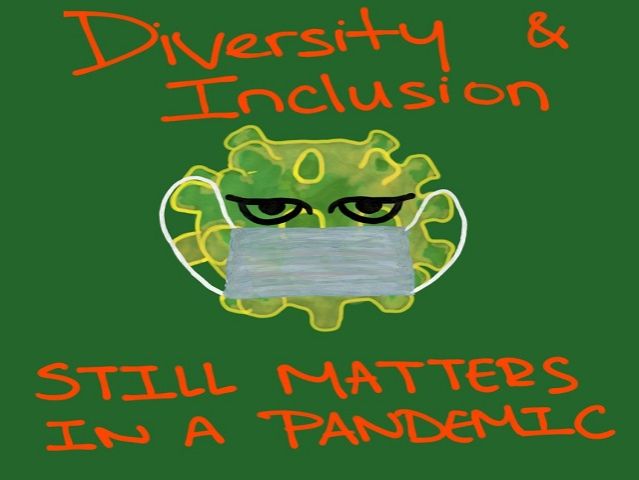Existing Patterns of Social Inequality Exacerbated under COVID-19
| Datum: | 19 mei 2020 |
| Auteur: | Edwina Wong |

As the world battles with COVID-19, we are confronted with unforeseen challenges. Many fear for their health and the health of their loved ones. Many tackle new working situations: teleworking in makeshift home-offices, gearing up for essential work, or – at the other end - being freshly laid off. For many, these experiences enforce a focus on the bottom-line, where individuals and organizations alike are prompted to think in terms of survival. In this context, diversity and inclusion may not seem “essential,” like something that “would be nice to have.”
Yet, the fact that we can recognize each other's struggles doesn't mean we are all affected by the virus in the same way, or that the measures to contain its spread impact us all equally. Magnified are having certain privileges (e.g., access to good healthcare and being able to work from home), while inequalities are sharpened (e.g., job insecurity, health status). The consequences of this pandemic will further exacerbate existing patterns of social inequality that have been around long before this pandemic.
It is important to recognize the patterns through which people are systematically affected to successfully respond to this pandemic. I will highlight some prevailing issues that stem from existing marginalizations pre-COVID-19. Although the findings related to the impact of COVID-19 are preliminary, when relating these findings to the broader research done on social inequality, these patterns are not new.
-
Pandemic Parenting [1]. The very infrastructure that makes full-time work possible for many people has shut down. Many people who telework from home with children under their roof are straining under the pressure of "pandemic parenting". While this situation affects parents generally, women in particular still assume a disproportionate share of care-giving responsibilities in heterosexual couples. This may have consequences in the overall career progression of these primary caregivers who are working around the clock to accommodate familial and working responsibilities.
-
Socioeconomic Class [2]. Many people in working class occupations are still in proximity to other people. For example, a grocery-store clerk cannot simply stop going to work, especially if their financial livelihoods are at stake. In the Netherlands, many stores remain open with sales personnel handling stock and dealing with customers. Wealthier people also tend to have fewer underlying health conditions that exacerbate COVID-19, and are more likely to be in a position to practice social distancing effectively. They may be able to stockpile for longer periods of times, for example, or they may be able to have occupations where they can work from home. They may live in housing situations where they can more easily distance themselves from their neighbors (versus a shared household, or more tightly packed social housing units). Even for those in lower income brackets who are able to telework, they may not always have the technological resources to do so optimally (e.g., more than one computers in a household for multiple people, high-speed internet, performant computers).
- Ethnic Minorities and Expats [3, 4]. Preliminary studies in the U.K. and U.S. show that a disproportionate amount of Black and Ethnic Minority people are suffering and dying from COVID-19. Health differences between racial and ethnic groups are often intertwined with socioeconomic reasons explained above (i.e., living conditions, working conditions) wherein ethnic minorities are disproportionately represented in lower income brackets. Moreover, various incidents prove that the corona outbreak has given rise to discrimination and racist attacks against Asian-presenting people. Expats, generally, may experience additional mental health issues from being far removed from dear ones who are in their heritage country, with which there is no certainty for when they may be able visit or care for them.
These are only some highly summarized examples for which these marginalized issues, in conjunction with the most relatable challenges of living through this pandemic, can have major consequences on the well-being and health of these particular groups. In reality, this pandemic actually makes existing social issues worse, which is why we must continue to be vigilant with diversity and inclusion. While organizations are understandably struggling under tremendous financial pressure, heeding to their staff to prevent burnout and illness needs to be prioritized to safeguard the longevity and health of our communities and our organizations.
Edwina Wong (c.y.e.wong rug.nl) is a PhD candidate at the Department of Human Resource Management and Organizational Behavior of the University of Groningen. With a training in Social and Organizational Psychology, her PhD research is on making workplace gender diversity interventions considerate of women of color.
[1] Smith & Johnson (2020). Gender Equity Starts in the Home. Retrieved from https://hbr.org/2020/05/gender-equity-starts-in-the-home
[2] Khazan (2020). How the Coronavirus Could Create a New Working Class. Retried from https://www.theatlantic.com/health/archive/2020/04/coronavirus-class-war-just-beginning/609919/?utm_medium=offsite&utm_source=medium&utm_campaign=all
[3] Stechemesser, Wenz, and Levermann, A. (2020). Corona crisis fuels racially profiled hate in social media networks. EClinicalMedicine.
[4] Kirby, 2020. (2020). Evidence Mounts on the Disproportionate Effect of COVID-19 on Ethnic minorities . The Lancet: Respiratory Medicine.


